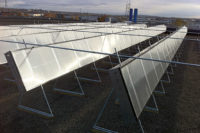In Sync
Take for instance the Rheem H2AC™ Rooftop Unit featuring eSync™ Integration Technology, which uses heat recovery science to reutilize exhausted heat that would typically be rejected into the atmosphere. Using Rheem’s proprietary eSync Integration Technology, the H2AC Rooftop Unit is able to preheat an establishment’s cold water supply from as low as 55°F to as high as 138°. The company estimates that this system can provide up to 50 percent savings on monthly water heating expenses and, in many cases, customers can reach the payback point on the investment in less than two years.
“We are just scratching the surface on how heat recovery technology can be used in commercial environments for energy savings,” said Erich Bauman, commercial product manager, air conditioning division, Rheem. “Using the wasted heat from an air conditioning cycle to preheat water has proven to be a very efficient model for commercial establishments — especially those that use a lot of hot water and air conditioning, like restaurants and hotels. As Rheem develops more products that integrate our HVAC and water heating systems, we anticipate that next-generation models employing heat recovery technology will have added efficiencies.”
Recovering Riches
The developers of Turtle River Montessori School in Jupiter, Fla., yearned for energy-efficient IAQ. Seeking suggestions, Brad Brown, executive vice president, KAMM Consulting, Deerfield Beach, Fla., the mechanical engineer for the developer, approached Charles Eno, sales engineer for Florida Air Conditioning Distributors, Orlando, Fla. Eno suggested high-efficiency air-to-air energy recovery ventilation (ERV) to reduce outside air (OA) load and recommended an ERV system from Airxchange® that contained an energy recovery wheel, also known as a heat wheel or enthalpy wheel. Airxchange offers a full line of ERV wheels that are sold through HVAC equipment manufacturers in integrated packaged systems, as accessories for packaged units, or as ERV options.
Upon taking the suggestion of Eno, Brown had the ERV installed. It recovered 70 percent of the school’s exhaust-air energy and recycled it. This allowed the architect to reduce the required size of the school’s packaged HVAC unit by half. In the end, the downsizing of the overall HVAC system paid for the ERV system, and the school has cut its utility bill by approximately $500 each month.
Solar Cooling Towers
The Abu Dhabi project is a pilot program designed to bring rooftop air conditioning to the city’s Transmission & Dispatch Co. (TRANSCO) via concentrated solar panels that will provide clean renewable solar energy to the building’s air conditioning system during peak demand hours.
“Essentially, the project is using solar power to produce cold water that is used to provide air conditioning,” explained Mohammad Alkarmi, CEO of Limitless Intl. Corp., Raleigh, N.C. “We believe that this unique cooling tower technology is the ideal solution for cooling applications in the Middle Eastern countries.”
Limitless Intl. Corp. is the exporting organization that sold the plastic cooling towers to the project’s management and is the authorized agent for Delta Cooling Towers in the Middle East.
Alkarmi noted that the solar-powered air conditioning project is a demonstration of how it is possible to capture the sun’s energy and create cooling power in desert heat. The project Abu Dhabi National Energy Co. PJSC (TAQA) and Chromasun Inc., a San Jose, Calif.-based solar panel manufacturer, installed 27 Chromasun Micro-Concentrator (MCT) solar panels on TRANSCO’s rooftop. The MCT-based system, which is designed specifically for rooftop applications and operation in high temperatures and dusty conditions, provides hot water to the absorption chillers, and from the absorption chillers they get cold water to their chilled water system.
“Essentially, they are simply using the hot water that is coming from the solar panels to get cold water from the chiller,” Alkarmi explained. “The HDPE [high-density polyethylene] plastic cooling tower will never rust or corrode and the manufacturer recently increased the warranty period from 15 to 20 years.”
Renewable Installations
While researching for a sustainable home to fit his scenic Colorado setting, Dr. Gregory Kettering, a veterinarian, discovered a design for a modular-built, energy-efficient two-story, 3,600-square-foot house. In Colorado, attacking heating costs was one of the first steps toward significant energy savings and Kettering chose to install a solar thermal system to cover much of the domestic hot water needs. He also chose to use the same solar thermal system to heat a radiant floor.
The solar energy preheats the water and additional heating can come from traditional sources, such as electricity or natural gas. Kettering’s system uses 50 percent biodegradable corn glycol and 50 percent propylene glycol. It uses two separate 164-gallon-capacity multi-energy tanks — one primarily for the domestic hot water and the other for the radiant floor heat.
The solar thermal panels were configured to first heat the domestic hot water tank to at least 130°, before addressing the radiant floor tank. When the first tank is satisfied, the second tank heats the radiant floor pipes.
The system employs evacuated solar tubes for the domestic hot water and radiant floor heat, backed up by an electric boiler. Approximately 2,900 feet of tubing was installed to heat the 2,595 square feet of radiant floor on the main level of the home. Five oversized panel radiators, sized to run at the same temperature as the radiant floor, were chosen to heat the upper level’s 888 square feet.
For much of the year, there is enough solar energy beaming down on the roof to heat all of the home’s hot water, as well as the radiant floor.
“During the warmer sunny days, I have been able to keep the boiler turned off 24 hours a day,” said Kettering. “The heat from the solar collectors maintains a good house temperature and provides adequate hot water.”
Publication date: 9/2/2013
Want more HVAC industry news and information? Join The NEWS on Facebook, Twitter, and LinkedIn today!











